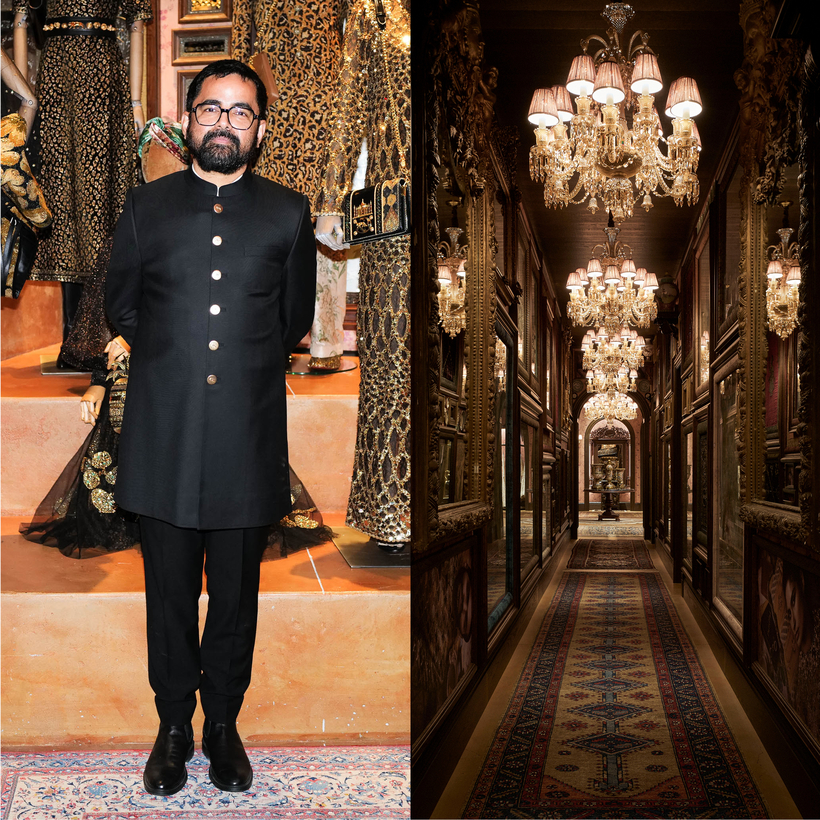Earlier this month, on a quiet corner of New York’s Christopher Street, waiters in turbans balanced flutes of Cristal on silver trays. More than a million dollars’ worth of artwork, coffee-table books, stuffed peacocks, and stately antiques were the setting for dazzling displays of diamond necklaces, dresses, and sequined jackets. Guests including Martine Assouline and Muriel Brandolini mingled under dozens of shimmering chandeliers. The occasion was the opening of the Indian fashion designer Sabyasachi Mukherjee’s 5,800-square-foot store.
“India’s such a culturally rich country,” Mukherjee told me while we toured the space a few days earlier, “and I want everyone to acknowledge that.”

The New York Times has referred to the 48-year-old designer, who lives in Calcutta, as the “Indian Ralph Lauren.” He’s dressed most of Bollywood, and designed the ornate red sari that actress Priyanka Chopra wore to marry the singer Nick Jonas. The actress Deepika Padukone was also dressed in a custom Sabyasachi item for her wedding, to the actor Ranveer Singh. Even Kim Kardashian wore a Sabyasachi sari at one point, documenting it on the requisite Instagram post in 2018.
The comparisons to Ralph Lauren are understandable—take the sumptuous, decadent décor in his stores, which are reminiscent of a Venetian palazzo (he has four stores in India), or the royal-Bengal-tiger logo, as omnipresent as the polo player on horseback.

The main difference is that while Ralph Lauren caters to Europeans and WASP-y residents of the American East Coast, Mukherjee tends to the scions of Delhi and Mumbai. But after more than 20 years of dressing Asia, Mukherjee marks his entry into a new market with the opening of his first New York store. Will the New Yorkers who grew up perusing Barneys and having lunch at Fred’s start buying Sabyasachi?
“Today, sophisticated customers want special handmade things that talk about different experiences, different parts of the world,” Mukherjee says. “It’s all about the quality,” a fundamental part of his designs. Every Sabyasachi item, from his signature saris to embroidered overcoats to wallpaper, is produced in Mukherjee’s own factory, in central Calcutta (not far from the town where he was born, Chandernagore, in West Bengal). He employs 1,000 artisans for beading, embroidering, weaving, and tanning, and 500 full-time staff.

In the special collection he’s created for New York (clothing starts at $450), browns, blacks, and beiges are at the forefront, and the evening dresses—some ornamented in gold, others black—feel more Met Gala than they do Bollywood. Mukherjee doesn’t sell the collection—or any of his clothes, for that matter—online. If a customer wants a dress, they have to come to one of his stores and buy it.
This isn’t Mukherjee’s first New York rodeo. Between 2006 and 2009, he showed loose experimental garb at New York Fashion Week. But “I was just a young designer,” he says, “starry-eyed, trying to bring my product to a market I had no idea about.” Lunch with his friend and confidante, the journalist Suzy Menkes, convinced Mukherjee to temporarily drop his American Dream. “She said, ‘Go back to India, build your business, and when you have a voice of power and confidence, you can always come back.’” He followed her advice.

Eleven years later, on an afternoon in 2020, he was taking a walk in the West Village when he spotted a vacant space in a nondescript building. Within two days, he’d signed a 15-year lease. This was no impulse buy, though.
Mukherjee’s business is projected to make $45 million in revenue by the end of this year, topping $35 million last year. And with streetwear reaching market saturation and merchandising replacing authenticity, wealthy, old-world shoppers are on the hunt for one-of-a-kind pieces from new, original brands.
“There is a tribe of bohemian customers that exist all over the world,” Mukherjee says, “whether they’re in Vietnam or Vienna, whether they’re in London or Paris or Istanbul. These are people who are intellectuals. These people go to Burning Man or Glastonbury Festival. They speak the same language; they eat the same kind of food; they dress the same way.”

For now, he tells me, the majority of his buyers are still Indian, Southeast Asian, and Saudi Arabian. But Mukherjee is counting on the business of this “bohemian tribe” that used to buy Saint Laurent before it dropped the “Yves.”
“I’m going to attract adventurous women who have strong personalities, are product-supreme and not brand-supreme customers,” he says. A quick survey of the guests at the opening of his New York store, fluttering around in printed vintage coats and well-cut blazers ahead of dinners at Via Carota and Indochine, seemed to embody the gauche-caviar ideal he describes.
“You see,” Mukherjee says as he shows me the gilded changing room, “the next 20, 25 years of fashion are going to be for people who are brave, people who can embrace authenticity. We have to make room for the creatives again.”
Elena Clavarino is the Senior Editor for Air Mail


